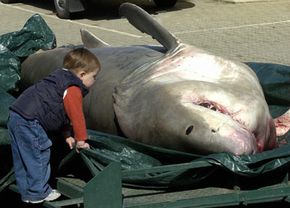Great White Shark Reproduction and Conservation
There are several unknowns in the great white shark's reproductive process; biologists have only been able to dissect about 10 pregnant females [source: McGhee]. Because of the scars on their fins, great whites likely practice the typical courtship rituals of a shark, which involve the male biting the female to hold her in place during insemination.
The great white shark is ovoviviparous, which means that the shark grows in an egg, which is then hatched inside the mother. Shortly thereafter, the shark pup is born. While in the womb, great white shark embryos feast on unfertilized eggs, a practice known as oophagy. It doesn't appear that they eat the fertilized eggs, as a few other species of shark has been known to do, but they may swallow their own teeth when they lose them for the calcium [source: Martins, Knickle].
Advertisement
The gestation period is estimated to be 12 to 18 months, but this is largely speculative [sources: McGhee, Francis]. The litter size of the great white ranges from two to 10 pups, although litters of up to 17 pups have been documented [sources: MarineBio, McGhee]. At birth, great white shark pups measure 5 feet (1.5 meters) and weigh about 77 pounds (35 kilograms). The great white grows slowly: Males reach maturity at age 9 or 10, while females are mature at 14 to 16 years of age. Scientists believe that they live about 30 years [source: Martins, Knickle].
Because of the long gestation period, it's possible that female great whites give birth every other year, taking some time to rest after mating. This low reproductive rate and slow growth to maturity are concerns to great white conservationists. Scientists are interested in learning more about the shark's reproductive habits so that they will know better what conservation methods are needed. As we mentioned, great whites face numerous threats from humans, including fishing for fins and teeth and hunting for sport.
Marine biologists lack exact numbers on the great white population, but they're seen very rarely and are currently listed as vulnerable, according to the International Union for Conservation of Nature and Natural Resources. To those who didn't go swimming for a year after "Jaws," worrying about the great white's numbers may seem silly. Wouldn't the world just be better off if these man-eaters weren't around?
Conservationists and scientists stress that a lot of our fear of the great white is in our head, and that these creatures serve an important role in the ecosystem, one example being that they eat seals, which in turn eat salmon. An abundance of seals could lead to the elimination of salmon [source: Martin]. Currently, great white sharks have been afforded protected status in South Africa, Australia and the United States.
To find out more about the great white shark, see the links that follow.
